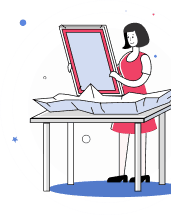11 Painting Mediums - Which One Is Best for You?
Author:
GeorgeUpdated:
22.01.2025
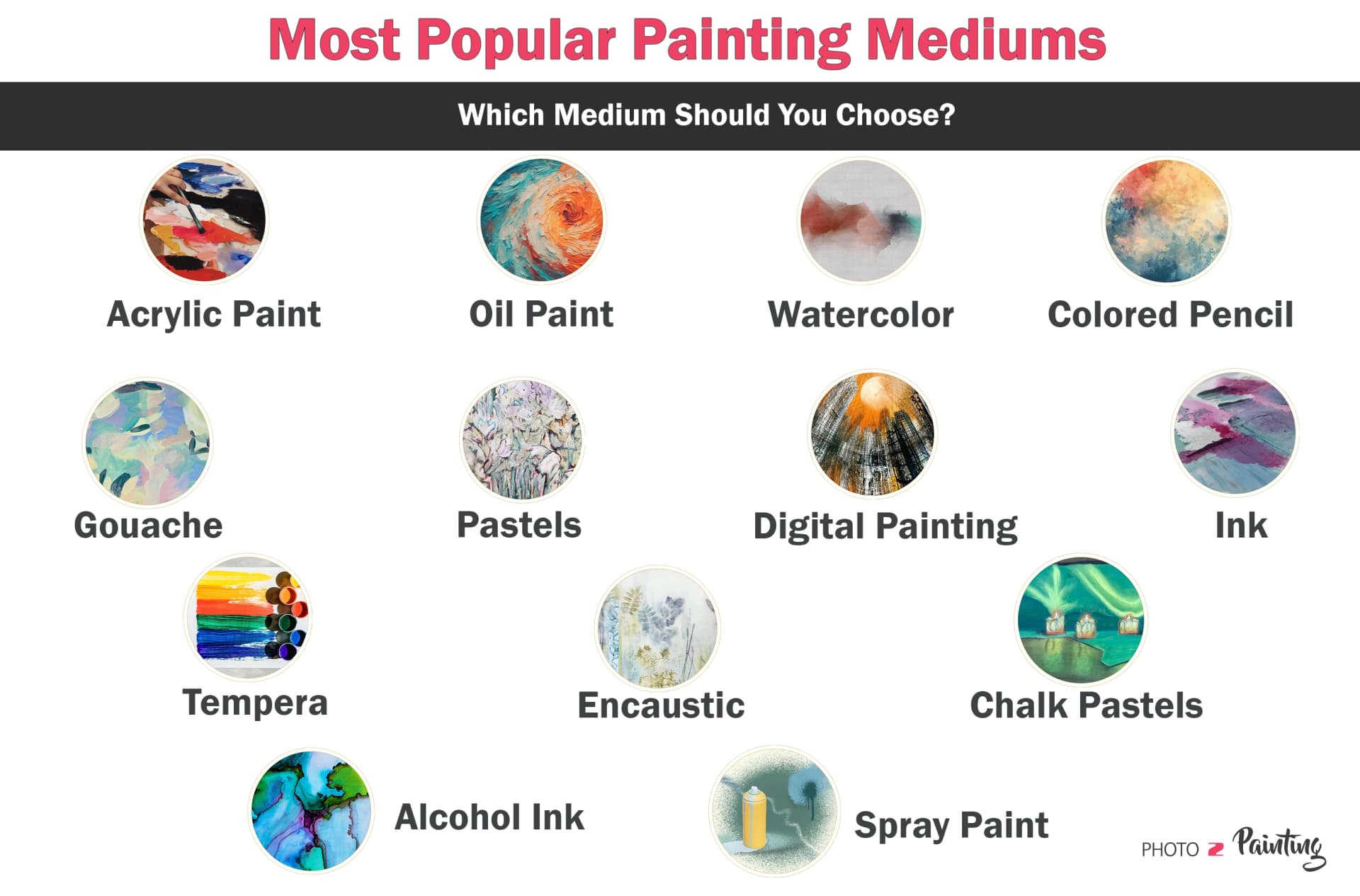
- What Are Painting Mediums?
- Popular Painting Mediums - Pros and Cons
- 1.Acrylic Paint
- 2.Oil Paint
- 3.Watercolor
- 4.Colored Pencil
- 5.Gouache
- 6.Pastels
- 7.Tempera
- 8.Digital Painting
- 9.Encaustic
- 10.Chalk Pastels
- 11.Ink
- 12.Spray Paint
- 13.Alcohol Ink
- 1.
- How to Experiment With Painting Mediums
Starting painting can feel overwhelming, and it’s definitely not cheap. You don’t want to invest in a medium you won’t enjoy. Everyone seems to swear by the medium they use, but who do you trust?
Each medium comes with its own quirks, tools, and techniques. Choosing one that doesn’t match your style can make creating art feel more stressful than joyful. Here’s a little tip, though - just start. You may not fully know which medium is right for you until you try it.
“The best way to discover your ideal medium is to try everything. Each medium teaches you something new about your style, technique, and preferences." - says Al Gury in his book "Foundations of Drawing"
However, to help you decide where exactly you should start, we’ve put together this objective guide. We’ll break down the pros and cons of each medium and share insights from seasoned artists to give you a clearer picture.
What Are Painting Mediums?
Painting mediums are the materials or substances artists use to create their artwork. In art, the term “medium” can refer to two things: the type of paint used and additives that modify paint.
- The type of paint used includes acrylics, oils, watercolors, gouache, pastels, and more. Each type of paint behaves differently, with unique textures.
- Mediums can also be substances added to paint to alter its properties. For example, you can use mediums to change the paint’s drying time, texture, flow, or finish. Some mediums make paint more fluid, while others give it a thicker, textured look.
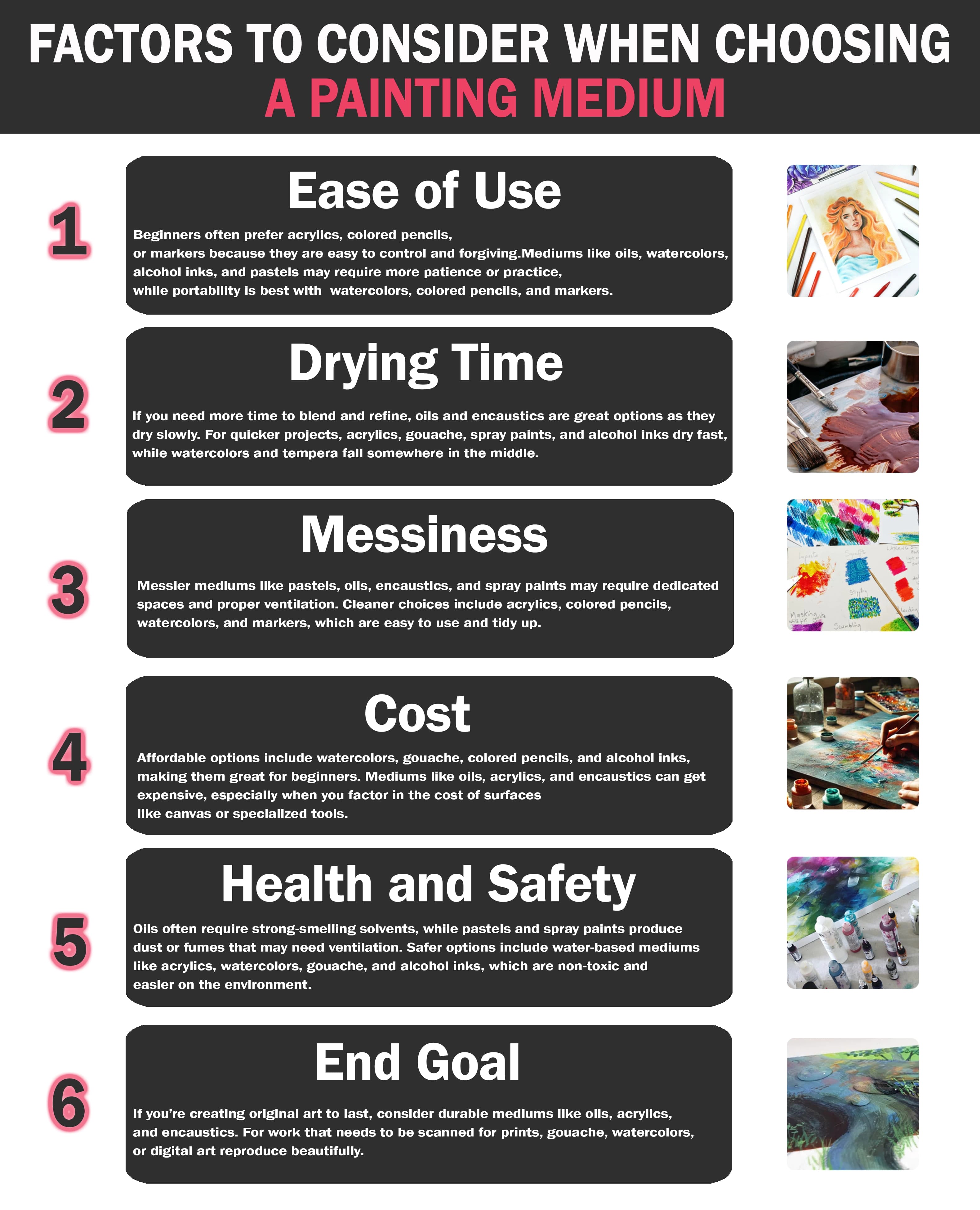
Every painting medium will give you a distinct experience and aesthetic. For example, oil paints are rich and blend smoothly. They take weeks to dry, while acrylics dry quickly and are more forgiving for beginners. On the other hand, watercolors are fluid and transparent, perfect for light, ethereal effects.
Mediums are as much about personal preference as they are about the artistic process. They allow artists to explore different techniques, styles, and effects, ultimately influencing how they express their creativity.
Popular Painting Mediums - Pros and Cons
Popular painting mediums include acrylics, oils, watercolors, colored pencils, gouache, pastels, tempera, digital paintings, encaustic, chalk pastels, ink, spray paint, and alcohol ink. Each medium has its unique characteristics, strengths, and challenges.
"Choosing a medium isn’t about finding the easiest or the hardest. It’s about finding the one that excites you every time you sit down to create." - says Danny Gregory, Illustrator and Author of "Art Before Breakfast".
Acrylic Paint
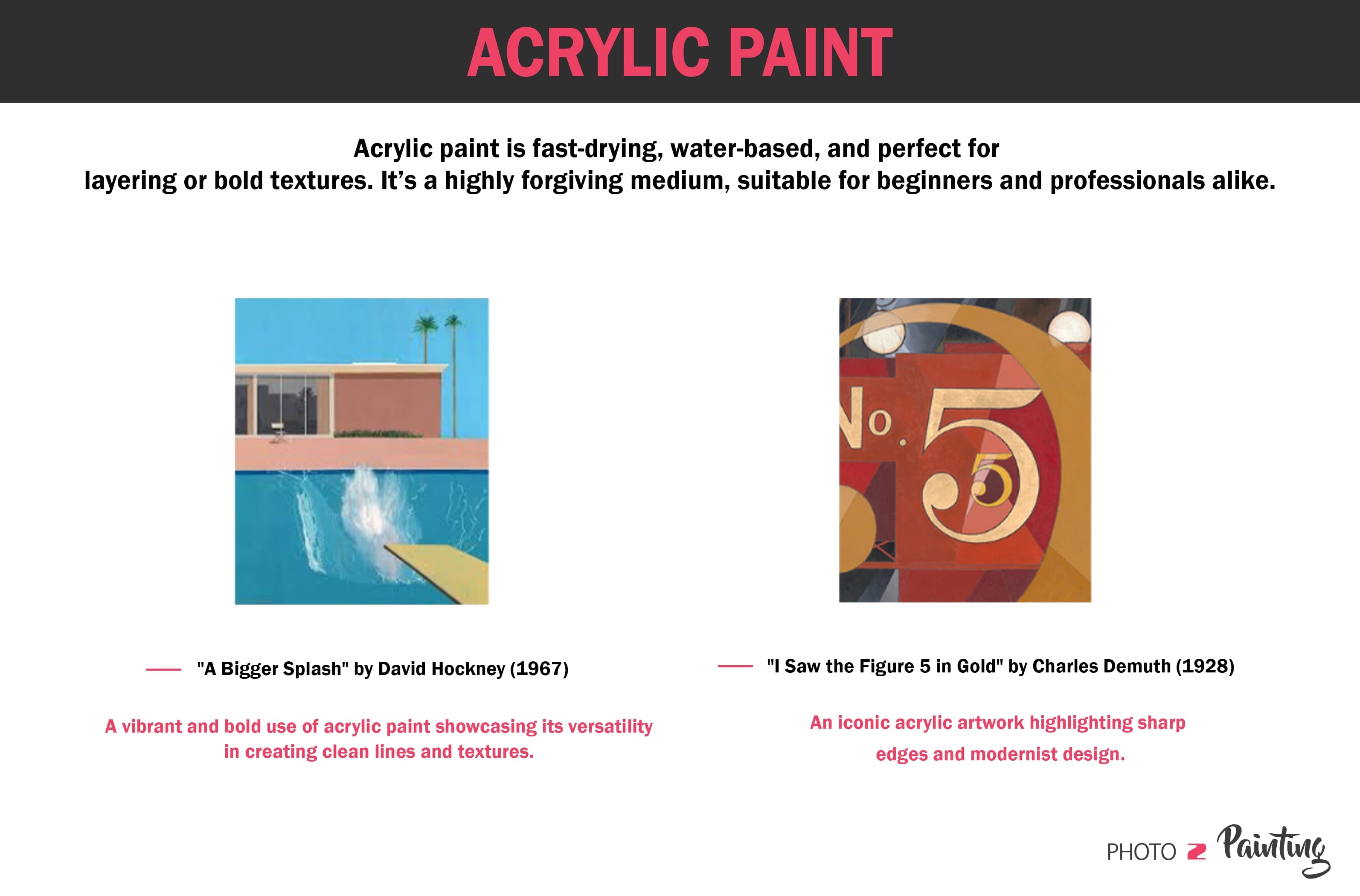
Acrylic paint is a favorite among beginners and professionals alike, thanks to its versatility and ease of use. It dries quickly, so you can layer colors in one sitting without waiting days for the paint to set. Acrylics can be used on a variety of surfaces like canvas, paper, or wood, and they’re water-based. The cleanup is easy with just soap and water. See what are some good acrylic painting techniques for beginners.
Pros:
- Fast drying for quick results.
- Easy to correct mistakes by painting over them.
- Works well for both thin washes and thick, textured applications.
Cons:
- Dries so quickly that blending can be challenging.
- Colors may appear less rich compared to oils.
Best for: Impatient artists, beginners, and anyone looking for a forgiving, affordable medium to experiment with.
Oil Paint
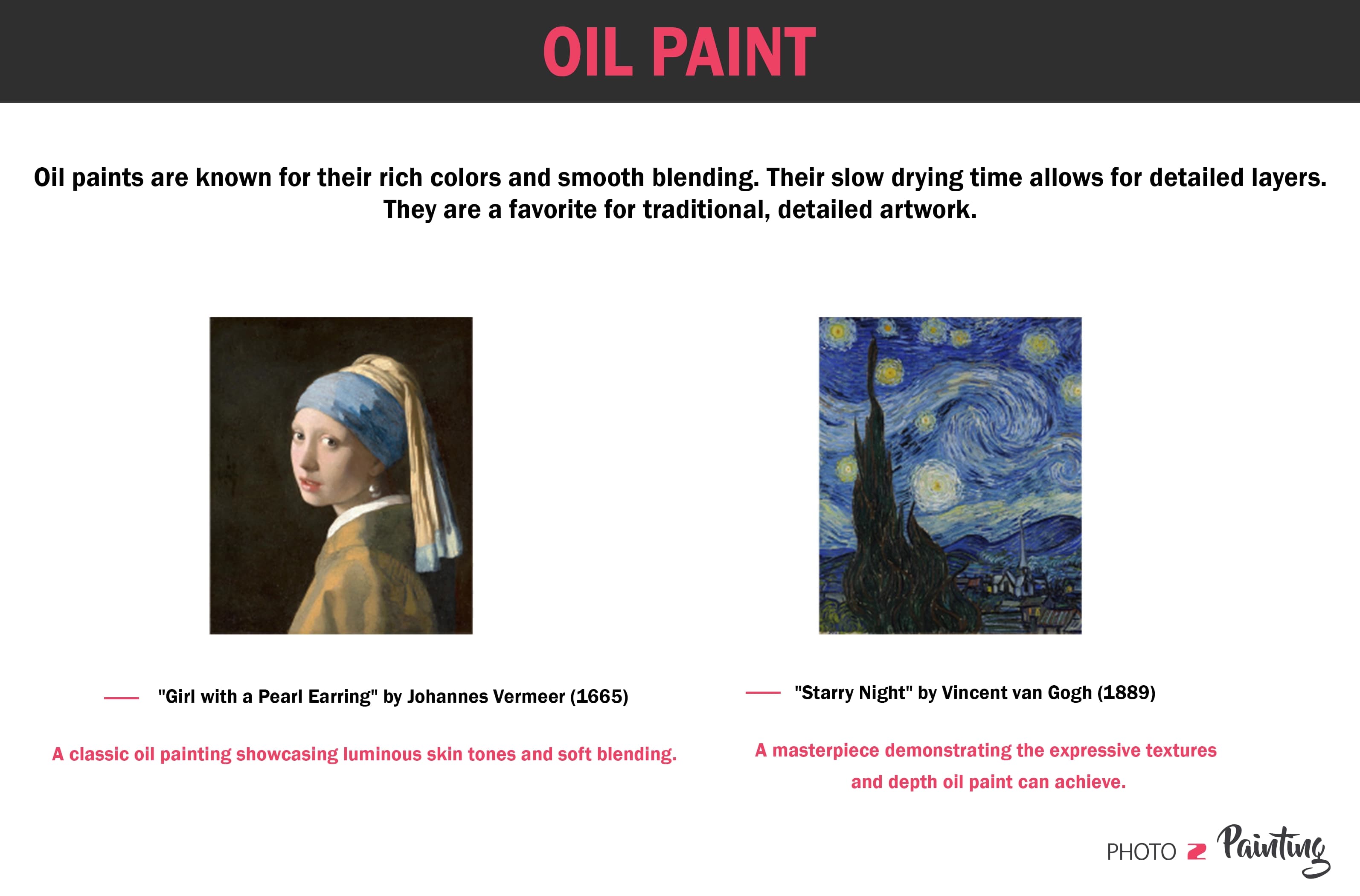
Oil paints have rich, vibrant colors and smooth blending capabilities and they’ve been a favorite for centuries. Their slow drying time allows artists to rework details and create layers over days or even weeks. However, they require special tools, solvents for cleaning, and a well-ventilated space due to their strong fumes.
Pros:
- Luxurious, vibrant colors with a smooth finish.
- Extended drying time allows for detailed blending and layering.
- Long-lasting results; many historical masterpieces are oil-based.
Cons:
- Slow drying time can delay progress.
- Requires solvents for cleanup, which can be messy and smelly.
- More expensive compared to other mediums.
Best for: Artists who value depth, detail, and a traditional approach to painting.
See some oil painting ideas for inspiration!
Watercolor
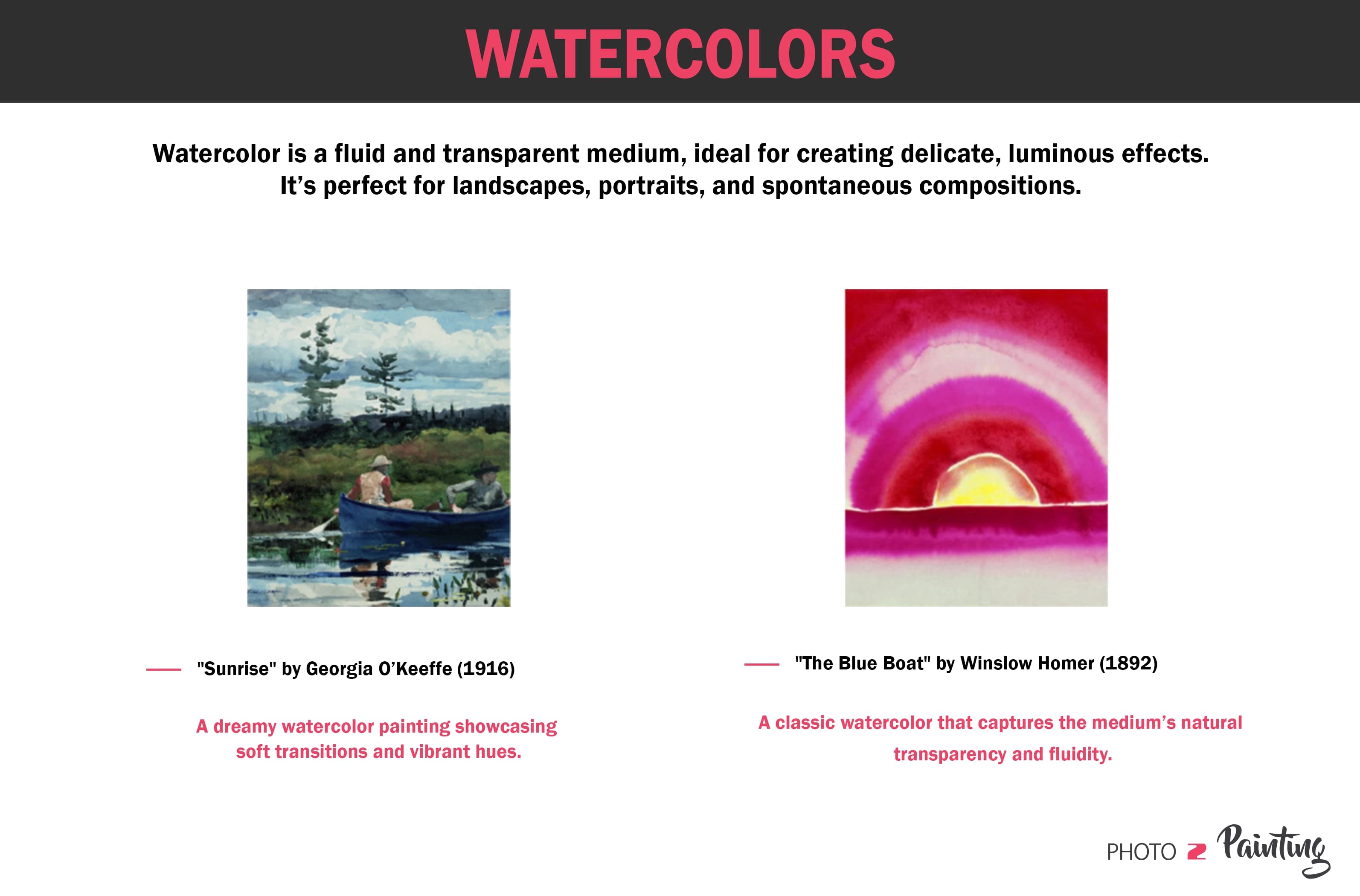
Watercolor paints are light, fluid, and perfect for creating soft, ethereal effects. This water-based medium is portable, affordable, and ideal for beginners and professionals alike. However, its transparency and fluidity make it less forgiving, as mistakes can be difficult to correct.
Pros:
- Lightweight and portable, great for travel.
- Creates beautiful, translucent layers.
- Affordable and easy to set up and clean.
Cons:
- Hard to control due to the fluidity of the paint.
- Mistakes are difficult to fix.
- Requires patience and planning, as colors are built from light to dark.
Best for: Artists who love soft, spontaneous effects and enjoy painting landscapes or expressive designs.
Colored Pencil
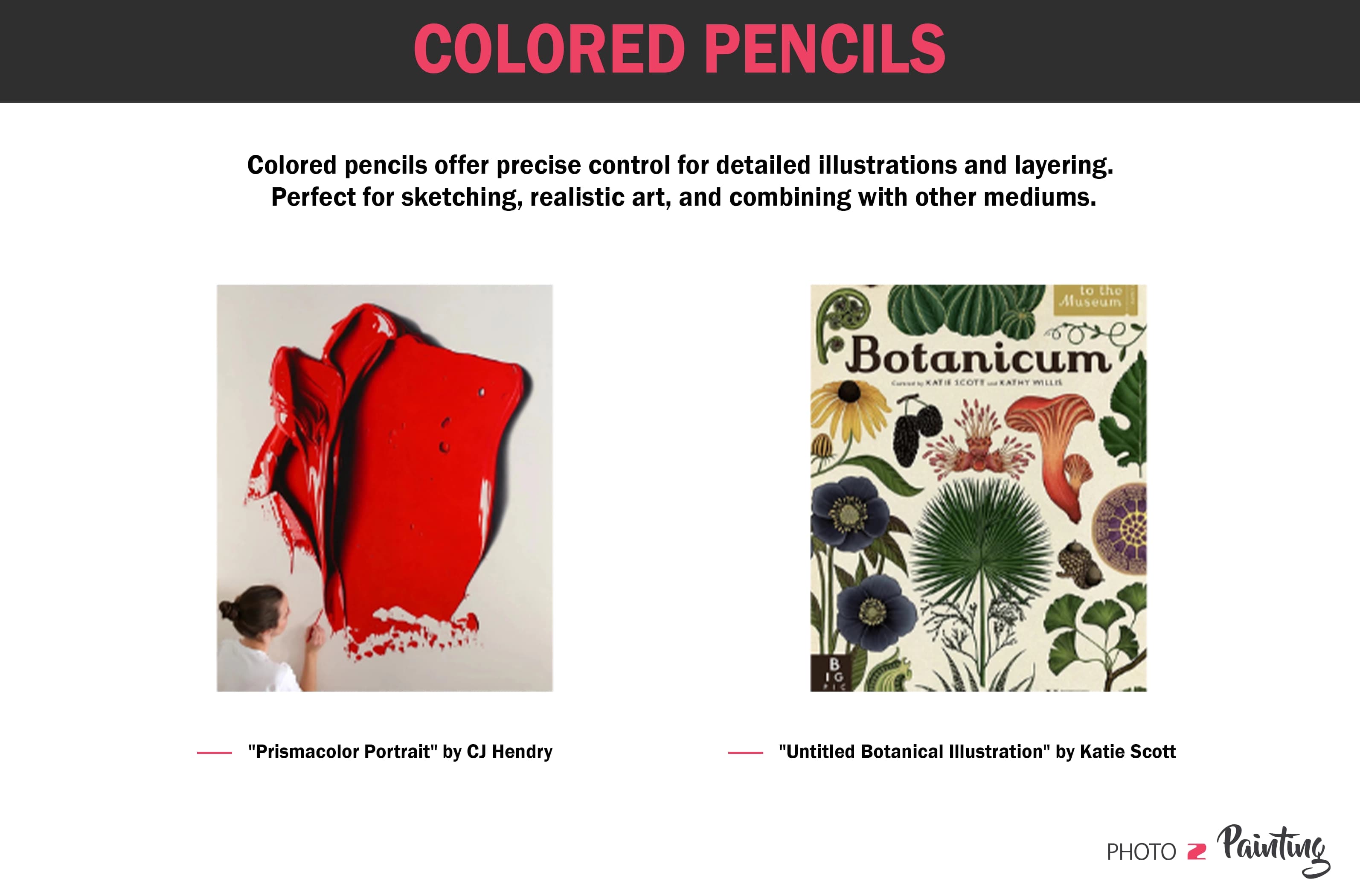
Colored pencils are a versatile and portable medium, perfect for both beginners and advanced artists. They give artists precise control over detailed work. So, they are ideal for illustrations and sketches. While layering is possible, it can be time-consuming for large areas.
Pros:
- Precise and easy to control for detailed work.
- Portable, affordable, and beginner-friendly.
- Works well with other mediums like markers or watercolor.
Cons:
- Covering large areas can be tedious.
- Requires sharpening and careful handling to avoid breakage.
- Limited blending compared to paints.
Best for: Artists who enjoy detailed illustrations, sketching, or combining mediums.
Gouache
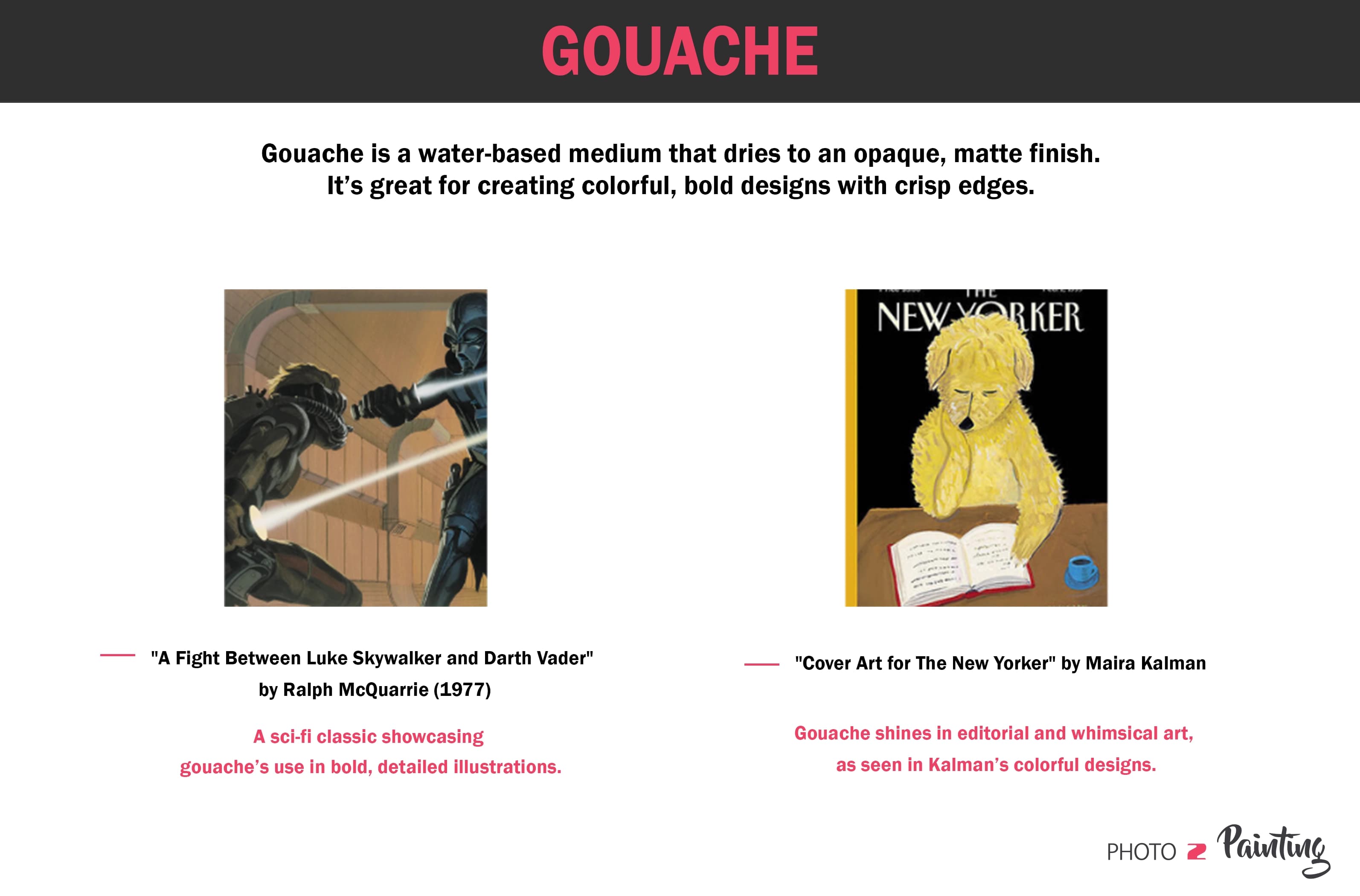
Gouache is a versatile, water-based paint that combines the best of both acrylic and watercolor. It dries to an opaque, matte finish, making it great for creating bold, vibrant pieces or illustrations. Gouache is easy to layer and rewet, but it can sometimes reactivate underlayers, requiring careful application.
Pros:
- Opaque and matte, perfect for clean, bold designs.
- Water-soluble and easy to clean.
- Can be layered like acrylic but behaves like watercolor.
Cons:
- Reactivates when wet, which can cause blending issues.
- Requires careful layering to avoid muddy colors.
- Less vibrant than acrylic or oil paints.
Best for: Illustrators, designers, and artists who enjoy flat, bold colors or want a mix of control and flexibility.
Pastels

Pastels are a tactile medium that comes in two main types: soft pastels, known for their rich, blendable colors, and oil pastels, which have a creamy, crayon-like texture. Both are applied directly to the surface. Hence, they are perfect for quick sketches or expressive artwork. However, they can be messy and require fixatives to preserve the final piece.
Pros:
- Soft pastels create vibrant, blendable colors and smooth transitions.
- Oil pastels offer bold strokes and a creamy application.
- No need for brushes or water—just draw directly onto the surface.
Cons:
- Soft pastels are messy and produce dust that can smudge.
- Oil pastels don’t blend as easily and can be difficult to layer.
- Both types require fixatives to protect the artwork from smudging.
Best for: Artists who love expressive, hands-on work or enjoy vibrant, textured effects in their art.
Tempera
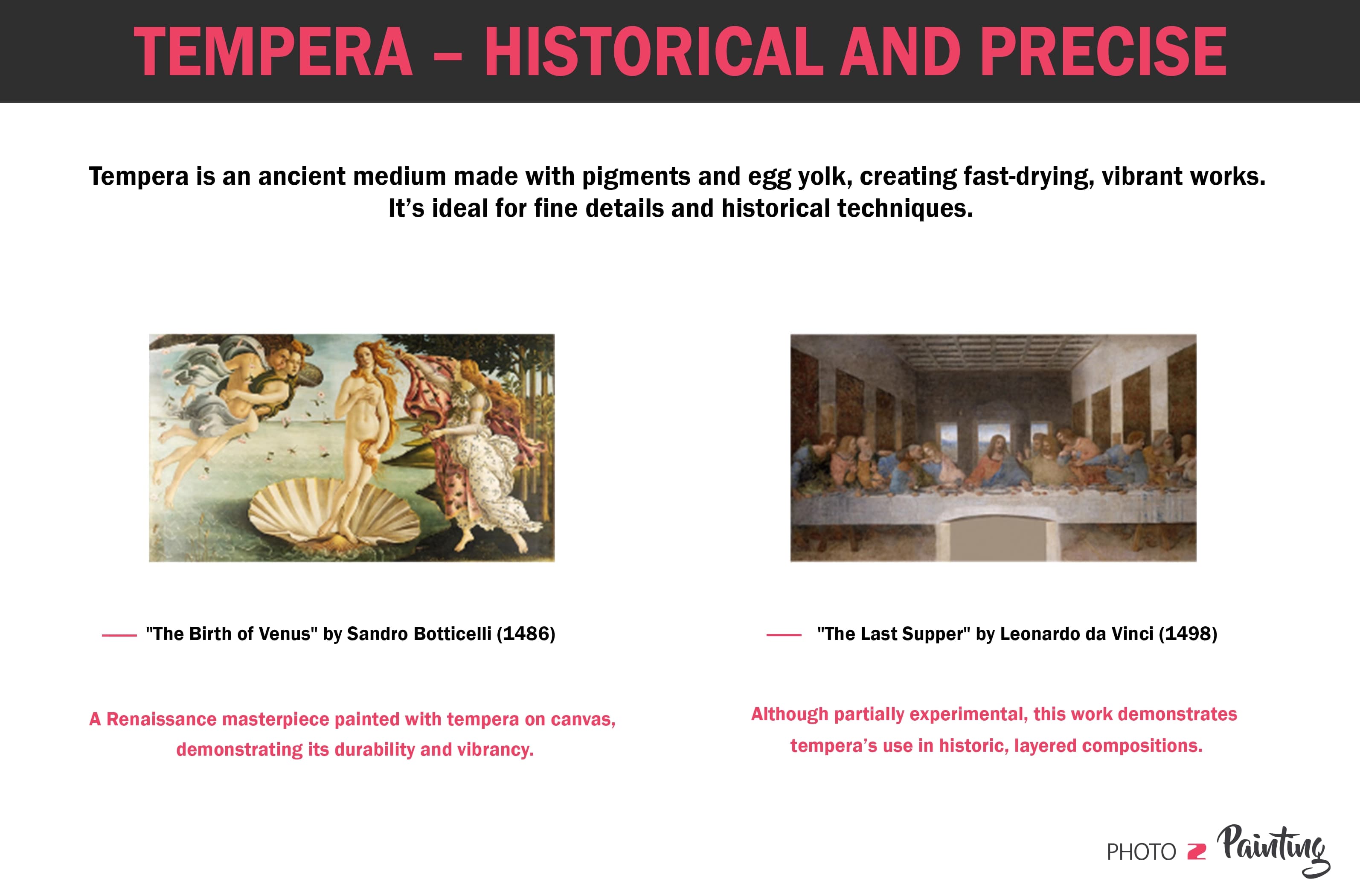
Tempera, also known as egg tempera, is one of the oldest painting mediums, dating back to ancient times. It is made by mixing pigments with a water-soluble emulsion, often egg yolk, resulting in vibrant, fast-drying, and durable paint. Tempera dries to a matte finish and works best for fine details, but it can crack if applied too thickly.
Pros:
- Quick drying time allows for detailed work and layering in one session.
- Vibrant, long-lasting colors with a smooth, matte finish.
- Easy to clean with water and relatively inexpensive.
Cons:
- Can crack if applied thickly or exposed to temperature changes.
- Less versatile compared to modern paints like acrylics or oils.
- Limited texture and blending capabilities.
Best for: Artists who enjoy working with traditional techniques or creating detailed, illustrative artwork.
Digital Painting
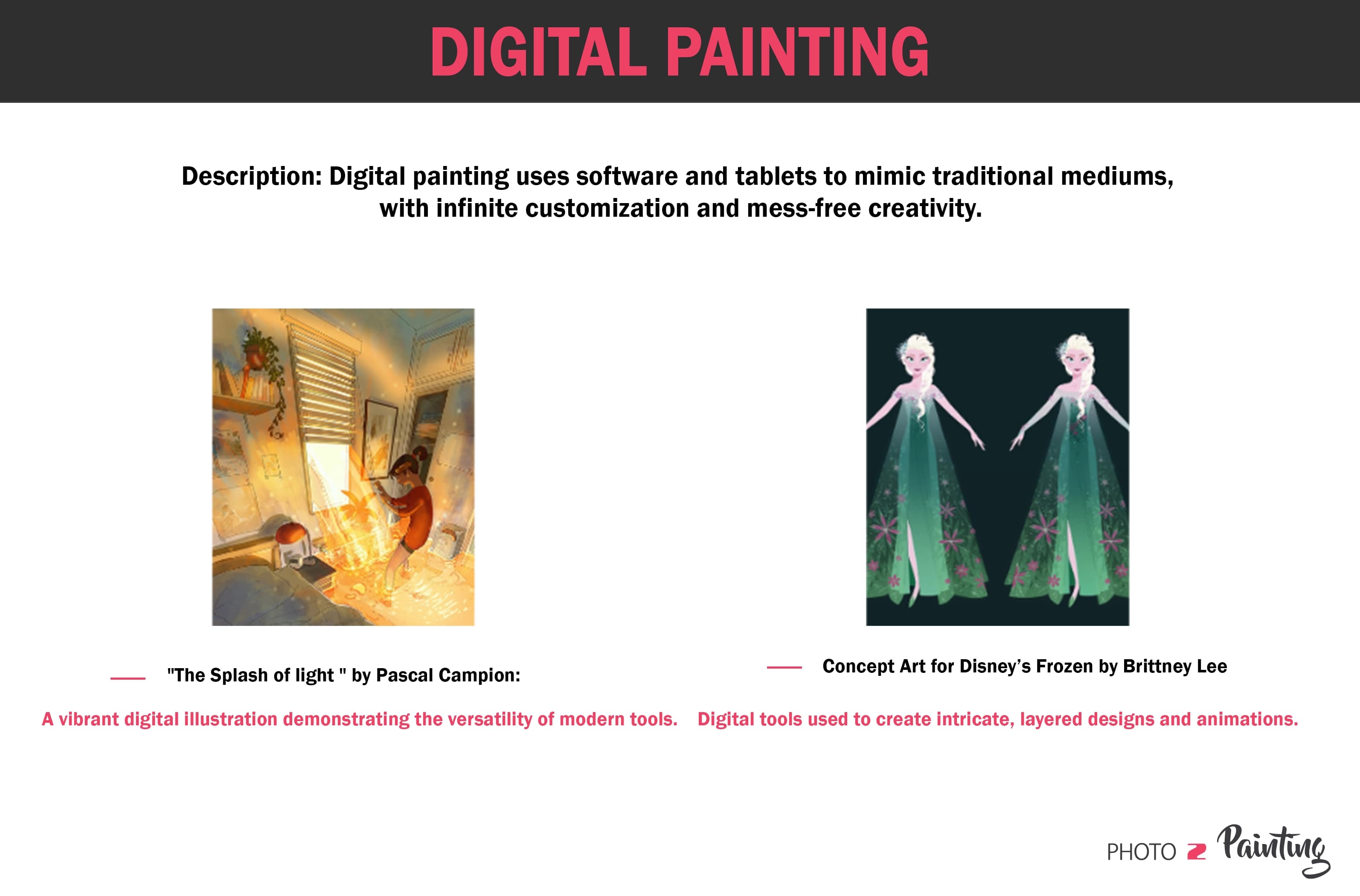
Digital painting uses modern tools like tablets, computers, and specialized software (e.g., Photoshop, Procreate) to create art. While it doesn’t use physical paints, it mimics the textures and styles of traditional mediums. It’s completely mess-free, portable, and ჰას infinite customization options, but it requires hardware and software investment.
Pros:
- No mess or cleanup; perfect for portability.
- Endless customization of brushes, textures, and effects.
- Easy to correct mistakes, layer, and experiment without wasting materials.
Cons:
- Requires devices and software, which can be costly upfront.
- Lacks the tactile experience of traditional painting.
- Art doesn’t exist in physical form unless printed.
Best for: Artists exploring modern techniques, creating digital prints, or looking for a mess-free, flexible way to experiment with their art.
Encaustic
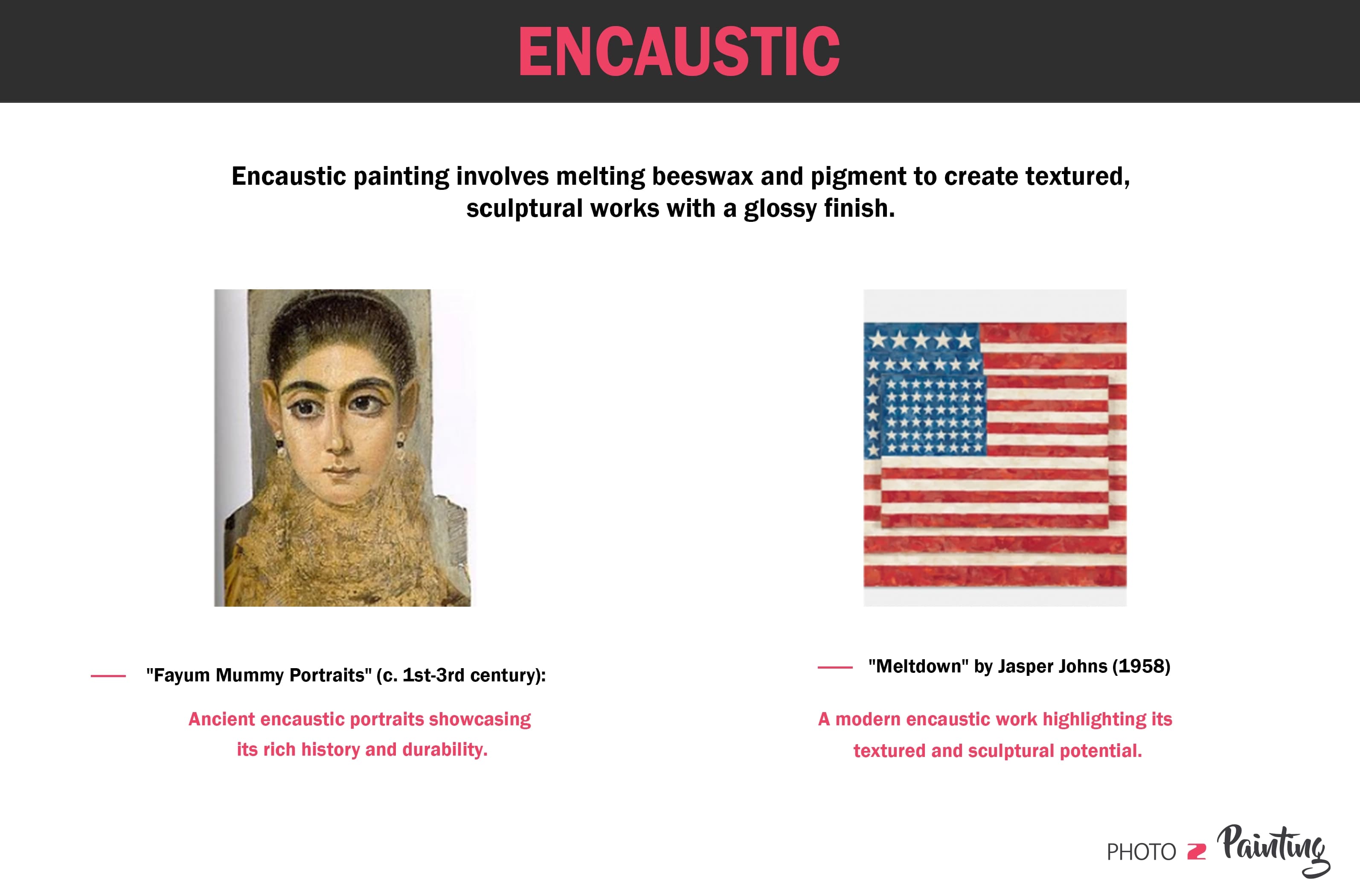
Encaustic painting uses melted beeswax mixed with pigment to create vibrant and textured works. The wax is applied with heat, allowing for sculptural effects and layered textures. It’s durable and has a glossy finish but requires specialized tools and safety precautions.
Pros:
- Creates unique textures and sculptural effects.
- Vibrant and durable with a glossy finish.
- Can be polished or combined with mixed-media techniques.
Cons:
- Requires a heat source and proper ventilation.
- Can be tricky for beginners due to its specialized tools.
- More time-consuming to work with than traditional paints.
Best for: Artists who love working with texture or enjoy experimenting with unconventional materials.
Chalk Pastels
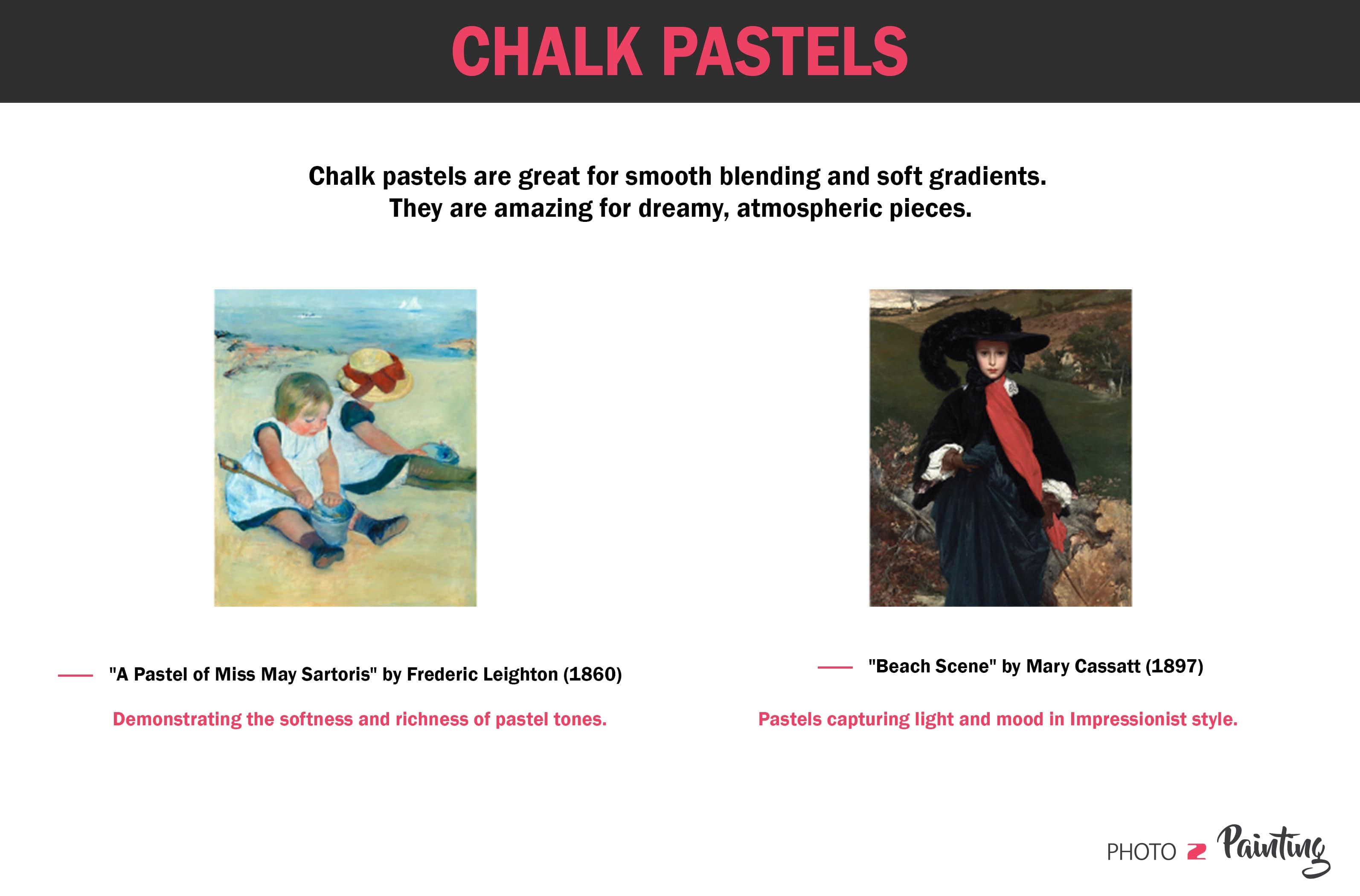
Chalk pastels are soft, blendable, and great for creating vibrant, smooth gradients. They’ll give you a tactile experience and are often used for expressive and impressionistic art. However, they can be messy, produce dust, and require fixatives to preserve the final work.
Pros:
- Smooth blending and soft, vibrant colors.
- Easy to layer and create atmospheric effects.
- Great for quick sketches or expressive pieces.
Cons:
- Messy and produces airborne dust.
- Smudges easily and requires a fixative for preservation.
- Dust poses a potential health hazard over time.
Best for: Artists who enjoy blending and working with soft textures or vibrant colors.
Ink

Ink is a bold and fluid medium perfect for creating detailed or minimalist artwork. It is commonly used in calligraphy, line art, and painting, with a wide range of expressive possibilities. Diluting ink with water creates soft, transparent effects similar to watercolor.
Pros:
- Ideal for fine details and bold, striking lines.
- Can be diluted for softer effects.
- Dries quickly and is excellent for layering.
Cons:
- Mistakes are hard to fix due to its permanence.
- Requires precise control for detailed work.
- Works best on specific surfaces like paper or board.
Best for: Artists who enjoy clean, detailed lines or expressive, flowing designs.
Spray Paint
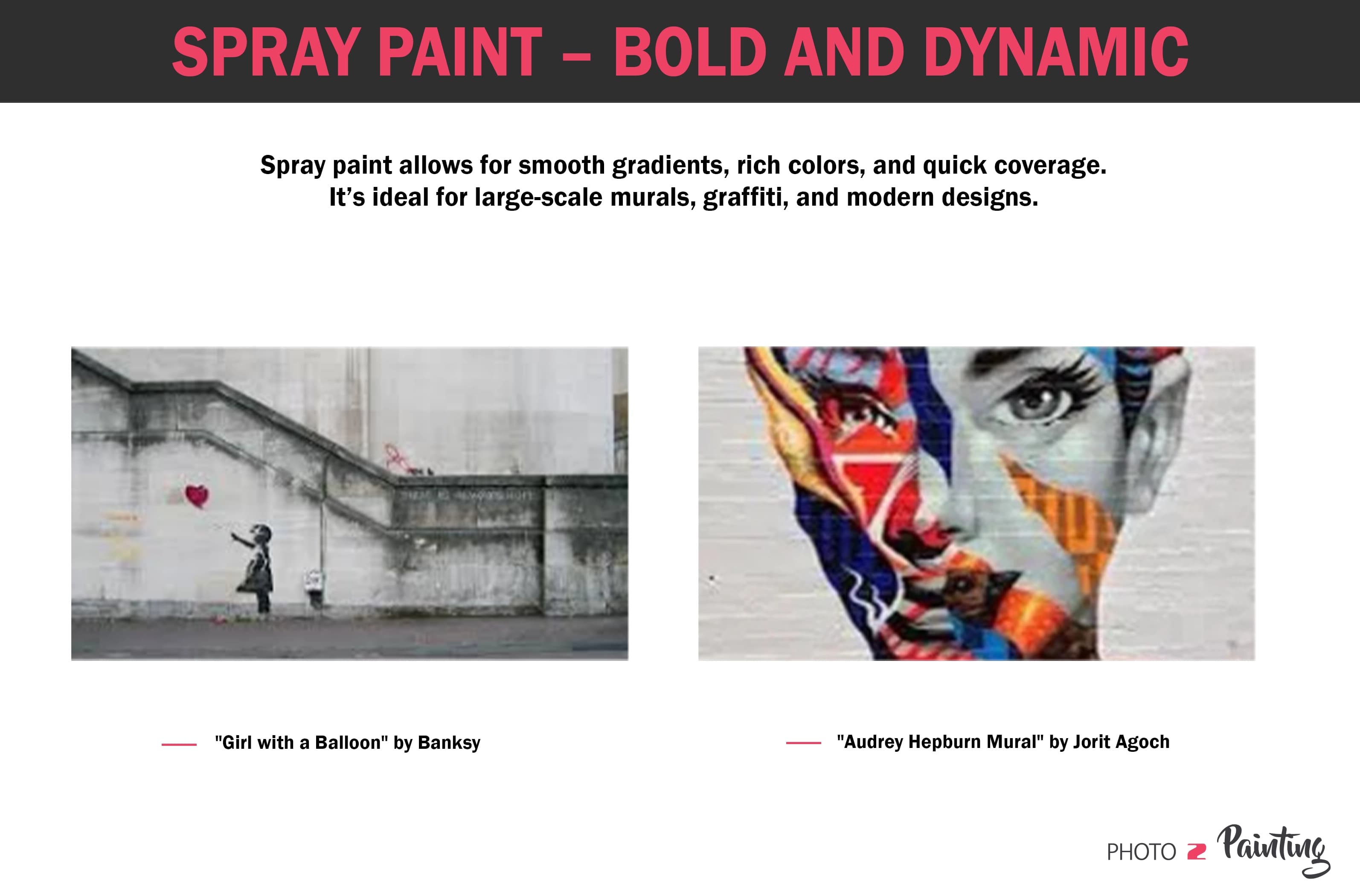
Spray paint is a modern medium often used for street art, graffiti, and large-scale murals. It allows for smooth gradients, bold colors, and quick coverage. While it’s a fun and dynamic medium, it requires a ventilated workspace and practice to control.
Pros:
- Great for large-scale works and quick coverage.
- Offers smooth gradients and vibrant colors.
- Allows for layering and stencil techniques.
Cons:
- Can be difficult to control without practice.
- Requires a ventilated area due to fumes.
- Limited to specific surfaces like walls, wood, or canvas.
Best for: Artists creating murals, graffiti, or bold, modern designs.
Alcohol Ink
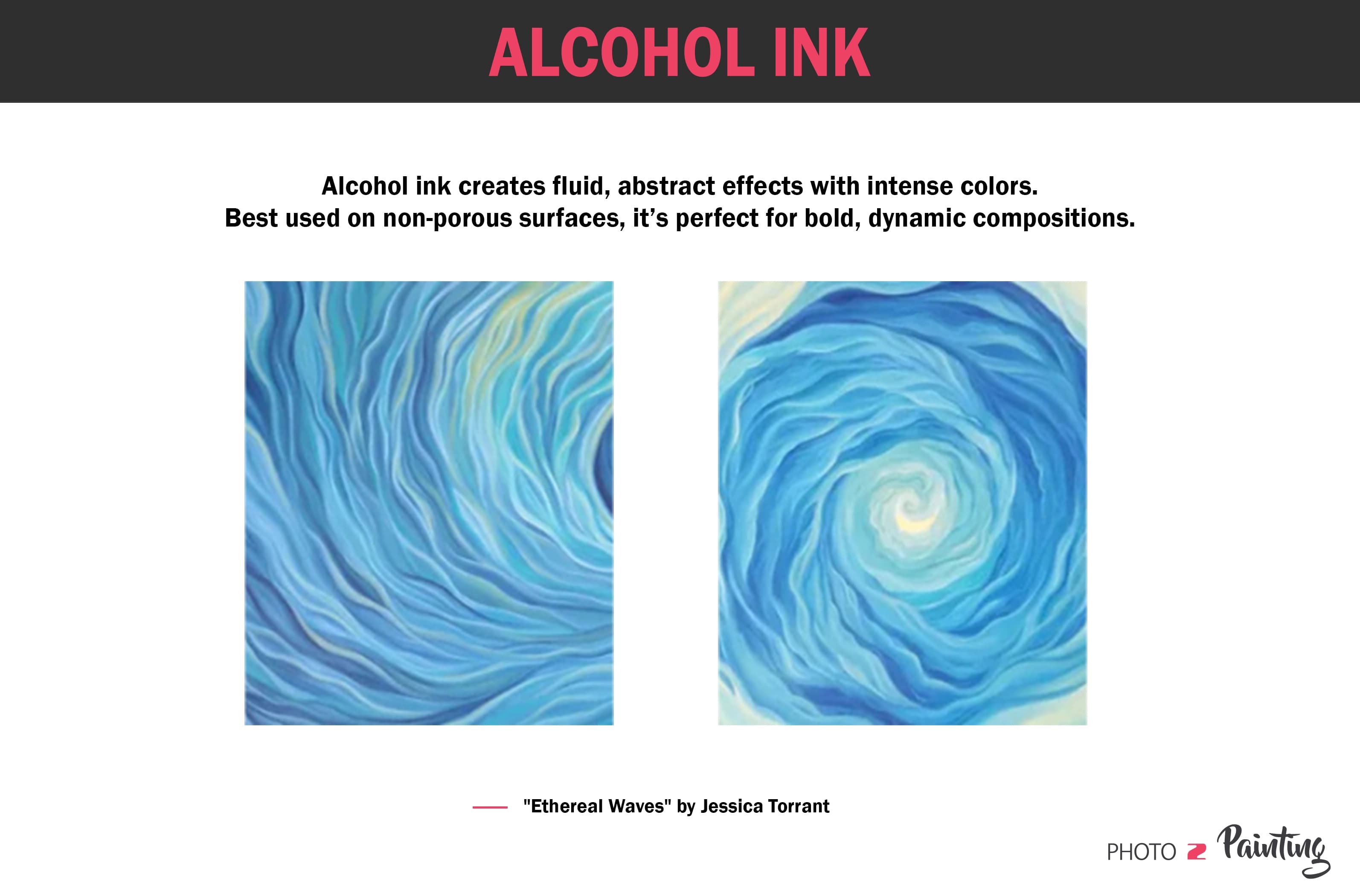
Alcohol ink is a vibrant, fast-drying medium used for creating abstract art, fluid designs, and intricate patterns. It works best on non-porous surfaces like glass, metal, or Yupo paper. Artists use alcohol or blending solutions to manipulate the inks and achieve stunning effects.
Pros:
- Creates vibrant, unpredictable, and fluid effects.
- Works well on non-traditional surfaces.
- Easy to manipulate with alcohol or blending solutions.
Cons:
- Limited control; results can be unpredictable.
- Requires specific surfaces for best results.
- Alcohol fumes can require proper ventilation.
Best for: Artists interested in fluid art, abstract designs, or working on unconventional surfaces.
How to Experiment With Painting Mediums
Finding the perfect painting medium starts with hands-on experimentation and you don’t have to spend too much!
- Buy Sample Sets
Instead of splurging on full-sized supplies, start with small sample kits or basic beginner sets to test a variety of mediums.
- Try Simple Projects
Start with small, low-pressure projects like abstract shapes, swatches, or landscapes to explore each medium’s properties.
- Use Free Resources
Watch free tutorials or take affordable online classes to learn how to work with different paints and techniques.
- Experiment with Mixing
Don’t limit yourself to one medium! Combine mediums like watercolor and ink or acrylic and pastel to see how they interact.
- Keep Notes
Track your experience with each medium—how it feels, dries, and blends—so you can compare and decide which one you enjoy most.
Experimenting is all about trial and error, so don’t worry about creating perfect artwork. Every test teaches you something new about your style and preferences.
Final Thoughts
Choosing the right painting medium can feel like a big decision, but it doesn’t have to be. The beauty of art is that it’s all about exploration and self-expression. There’s no right or wrong choice, only what feels natural to you.
Remember, the key is to start. If you need more guidance, read more tips for beginner artists. Try different mediums, experiment with techniques, and don’t be afraid to make mistakes. Art is a journey, and every brushstroke or pencil mark teaches you more about your style and preferences. Over time, you’ll find the medium that not only feels like an extension of your creativity but also helps you tell your story.
If you're still unsure, take some inspiration from the experts! Scroll through our custom paintings collection and see how professional artists use different mediums. You may just discover which medium feels like your cup of tea. Happy painting!
Frequently Asked Questions
What are 5 mediums of painting?
The five most common painting mediums are acrylics, oils, watercolors, gouache, and pastels. Each medium has unique properties: acrylics are fast-drying and versatile, oils are rich and blendable, watercolors are transparent and fluid, gouache is matte and opaque, and pastels offer vibrant, hands-on color application.
What kind of paint do professionals use?
Professional artists often use oil paint for its richness, blendability, and longevity. Acrylics are also widely used for their versatility and fast drying time. For illustrations or mixed media, professionals may turn to gouache or watercolors. Ultimately, the choice depends on the artist’s style, preferences, and the type of artwork they’re creating.
What kind of paint is best for canvas?
The best paint for canvas is acrylic paint because it adheres well, dries quickly, and works for both beginners and professionals. Oil paint is another excellent choice for canvas, offering smooth blending and vibrant, long-lasting results. Both are ideal for creating durable and impactful artworks on canvas.
What is pouring medium?
A pouring medium is a liquid additive used with acrylic paint to improve its flow and consistency without diluting the pigment. It’s commonly used for fluid art techniques like acrylic pouring, where the paint is poured onto a surface to create smooth, flowing patterns.
What is the cheapest art medium?
The cheapest art medium is colored pencils or watercolors. Both require minimal supplies—colored pencils only need paper, and watercolors require a small set of paints, a brush, and watercolor paper. They are affordable, beginner-friendly, and easy to use.
What is the most expensive art medium?
The most expensive art medium is oil paint, primarily due to the cost of high-quality pigments, canvases, and solvents like linseed oil or turpentine. Additionally, encaustic painting (using melted beeswax) and gold leaf applications can also be costly due to the specialized materials and tools required.
George, CEO of Photo2painting, is a passionate art lover and entrepreneur. He founded Photo2painting.com from scratch, inspired by his artist friends. As the company's CMO, he manages content and marketing.
Excellent Customer Reviews
